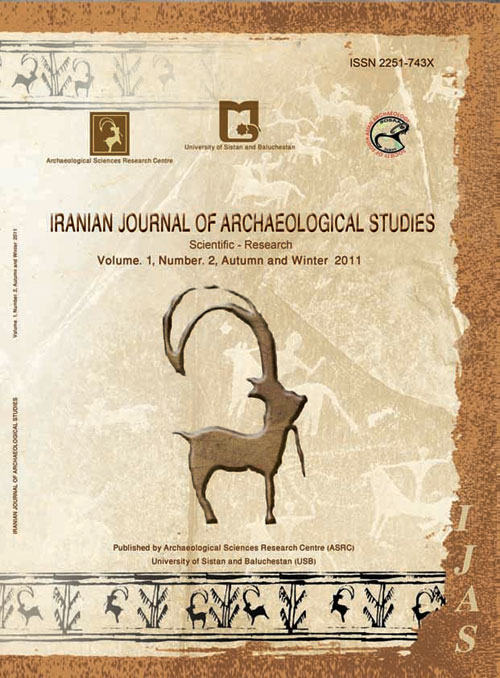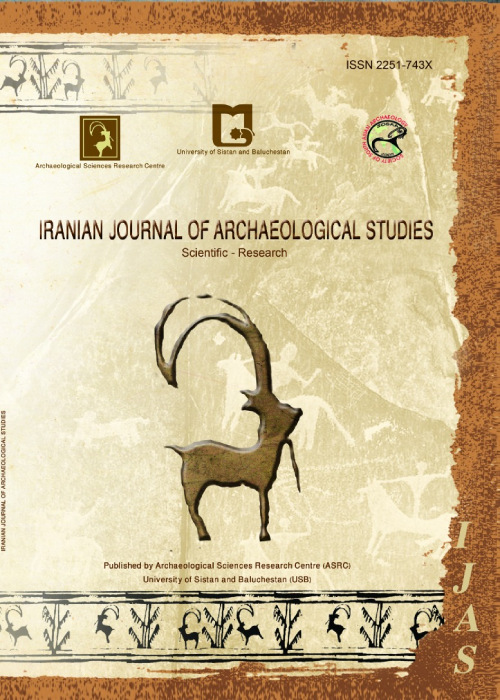فهرست مطالب

Iranian Journal of Archaeological Studies
Volume:6 Issue: 1, Winter and Spring 2016
- تاریخ انتشار: 1395/03/30
- تعداد عناوین: 7
-
-
Pages 1-9
This paper selectively reviews some recent themes in archaeological theory: a philosophical pragmatism, a turn to materiality, and understanding the past in the context of the present. It concludes with some reflective comments on the authors Archaeological Theory: An Introduction, in advance of the third revised edition.
Keywords: theory, pragmatism, materiality, politics, diversity -
Pages 11-17
The East Chia Sabz site is located on the bank of the Seymareh River in the middle of the Zagros Mountain chain. The site is among the few examples of the acramic Neolithic sites of the 8th millennium B.C. of Zagros which was archaeologically investigated during the rescue archaeological studies of the Seymareh dam. Numerous bullet-shaped cores were unearthed during the archaeological excavation of the site, from which twenty were investigated using XRD and XRF analyses. According to the results, most of the lithic artifacts demonstrate a similar mineralogy and geochemistry and are mainly composed of a cherty material with some impurities of calcite, chlorite, hematite and clay minerals. The presence of these impurities has lowered the cutting quality of these lithic materials. It seems that the cores had been provided from a local source. In this regard, the chert cobbles of the Amiran Formation that are also available from the river beds of the area could have been a significant source.
Keywords: Zagros, Mineralogy, geochemistry, XRD, XRF, Amiran Formation, lithic industry -
Pages 19-29
Sonqor Koliyaie is a mountainous plain in central Zagros that has attracted the attention of human societies because of its appropriate environmental characteristics from long ago. Generally, the findings obtained from systematic archaeological surveys show that human settlements have been established in this area from Middle Paleolithic period through contemporary period. Three seasons of survey in this area have shown that among 301 discovered archeological sites, many belonged to Paleolithic, Epipaleolithic, Neolithic, Chalcolithic, Bronze, and Iron Age. The present study attempts to study the prevalent prehistoric cultures and traditions of the region since the beginning up to the first millennium BC. The research method is descriptive-analytic and the materials are cultural artifacts such as pottery and stone tools. The obtained results prove that although the number or size of the settlements has decreased during some periods, the common pottery traditions such as Dalma, Seh Gabi, Godin VII, VI, IV, III, and II in West of Iran show the presence of a continuous sequence of cultural settlements from the start of the human settlement in the valleys. Regarding the distribution of the sites, it should be noted that the distribution and size of the discovered settlement patterns have been different indifferent periods and have been influenced by various environmental factors such as height, water access, pasture, and communicative roads.
Keywords: Prehistoric, Central Zagros, Sonqor Koliyaie, pottery traditions -
Pages 31-43
The present work is associated with dietary reconstruction using δ13C and δ15N analysis of humans from the site of Sidon, a Middle Bronze Age (2000BC-1550BC) settlement in Lebanon. The main objective of this research is to focus on collagen extraction of 23 individual bones, discovered in a cemetery, College site (season 2001-2002) in ancient Sidon. Collagen could only be extracted from the 8 adults and 11 sub adults and one faunal sample excavated during the 2001-2002 seasons. Carbon and nitrogen stable isotopes, which are two important tools in palaeodietary analysis, can tell us about the protein sources of the diet. δ13C values shows the proportion of terrestrial against marine protein in the diet and what sort of photosynthetic pathways, including C3, C4, or CAM, were consumed in populations during their lifetime, while δ15N values reveal the proportion of animal against plant protein and also provide an indication of the age of weaning. In this study according to the carbon isotope values, the results show that these individuals were consuming terrestrial food stuffs, typically C3 plants, including cereals such as wheat, barley, rice, as well as lentils and milk products. The nitrogen isotopes indicate that protein originated from a mixture of terrestrial plant and animal food. The animals probably were herbivores such as sheep and goats, which consumed C3 plants. Also, the nitrogen values estimated age of weaning in infants in this population. Infants were breast-fed and their weaning may have been occurred between the ages of 18 months and 3-4 years. The most surprising results of both isotopes are that no trace of C4 plants or marine products was seen, while the site is situated along the Mediterranean Sea.
Keywords: Bronze Age, stable isotopes, palaeodiet, Lebanon, Sidon, ?13C, ?15N -
Pages 45-57
Prehistoric archaeological sites in the center of the Iranian Plateau suddenly disappeared around the end of the 4th millennium BCE. At Tepe Sialk, near Kashan, the last cultural period, namely Sialk IV - probably established around 3400 BCE after the last settlements of Sialk III6-7b - was abandoned approximately after 500 years. The material culture of this period, known as Proto-Elamite period, is very different from the previous one, showing similarities with Susa III. This period belongs to the same horizon of Uruk III in Mesopotamia and similar evidences were discovered also at sites such as Sofalin, Shoghali, Pardis, Chaltasian, Meymanat Abad, Gholi Darvish, Maral Tepe (Uzbeki), Ghabristan, Arisman and Hissar. With the abandonment of Sialk IV, cultures affected by Uruk in Near East were simultaneously abandoned. This trend of abandonment documented in the center of the Iranian Plateau continued for about 500-1500 years. Palaeo-climatological studies show that this period coincides with a cold and dry period dated approximately between 3200 and 2700 BCE. Apparently, these climate fluctuations threatened life more at the center of the Iranian Plateau than in Mesopotamia and Khuzestan, by virtue of the presence of overflowing and permanent rivers in these territories (Euphrates and Tigris above all), probably forcing the migration of people from the center of the Iranian plateau to more favourable areas. The present comparative study suggests that climate changes were the main reason for the cultural collapse attested in the region.
Keywords: Iranian plateau, Sialk IV, Middle Holocene, late Holocene, Climate Changes -
Pages 59-82
The site of Kul Tepe is located near the city of Hadishahr, in Eastern Azerbaijan Province. It is an ancient multi-period mound, having an extension of about 6 hectares and rising 19 meters above the surrounding land. The second season of archeological excavations at the site, carried out in 2013, aimed at clarifying its chronology and its settlement organization. In the meantime it aimed at elucidating fundamental questions concerning the transition process from Late Chalcolithic to Early Bronze Age, at identifying different cultural horizons (including Proto-Kura-Araxes and Kura-Araxes I periods) and also at outlining cultural conditions of the region during prehistoric and historic periods. The present paper exposes briefly the main stratigraphic, architectural and material data from the site. On the basis of the results from the first and the second seasons of excavation, it is argued that Kul Tepe possessed cultural material pertaining to Late Neolithic/Early Chalcolithic (Dalma), Late Chalcolithic (Pisdeli=LC1; LC2 and LC3=Chaff-faced Ware), Proto-Kura-Araxes and Kura-Araxes I, Early, Middle, Late Bronze Age, Iron III, Urartian and Achaemenid periods.
Keywords: Kul Tepe, Northwestern Iran, Radiocarbon dating, Prehistoric period, Historical period -
Pages 83-87
This is an invited review of the new volume by Ayşe Gürsan-Salzmann (2016) entitled "The New Chronology of the Bronze Age Settlement of Tepe Hissar, Iran". University Museum Monograph 142, University of Pennsylvania Museum. 408 pages | 8 1/2 x 11 | 238 illus. ISBN 978-1-934536-83-4 | $69.95s | £45.50). In general, this reviewer finds the book to be of great interest to specialists and students of the Chalcolithic and Bronze Age archaeology of Iran. Dr. Gürsan-Salzmann has done extensive study of the Erich Schmidt collection of artifacts and excavation notes housed in the United States, and presents here a larger portion of the unpublished material from Schmidt's 1930s research at the site near Damghan. While there is still more material unpublished, this volume provides a framework for future studies of Tepe Hissar and other sites in the region. The author should be commended for her excellent work and perseverance with very difficult archival material.


